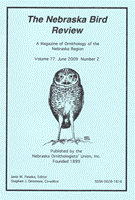Nebraska Ornithologists' Union

Nebraska Bird Review
Date of this Version
9-2014
Document Type
Article
Citation
Valenziano and Labedz, "Stomach Content Analysis of Recent Snowy Owl (Bubo scandiacus) Specimens from Nebraska," from Nebraska Bird Review (September 2014) 82(3).
Abstract
The Snowy Owl (Bubo scandiacus) is a circumpolar bird of prey that breeds in extreme northern latitudes, including Canadian and Alaskan tundra. During winter months, some immature and non-breeding birds disperse south. North American birds may travel to southern Canada and northern parts of the United States, and in some extreme cases as far south as Oklahoma and Texas (Parmelee 1992). Although not fully understood, these irruptive events may be caused by the abundance of prey in northern Canada and Alaska (Parmelee 1992).
Prey typical of Snowy Owls are small mammals (e.g., lemmings and hares) of their home range and an occasional bird from a variety of species including waterfowl (Parmelee, 1992). Research on prey items selected by birds outside of breeding range in North America primarily includes ducks and grebes in southwest British Columbia (Campbell and Maccoll 1978), voles in Montana (Detienne et al. 2008), and mice and voles in southern Alberta and Michigan (Boxall and Lein 1982, Chamberlin 1980, respectively).
Over the past century, several irruptions of Snowy Owls have been recorded in Nebraska, most notably during the winters of 1917-18, 1954-55, and 2011-12 (Jorgensen et al., 2012). The most recent of these irruptions, during the winter of 2011-12, produced the largest number of confirmed Snowy Owl sightings in Kansas and Missouri, possibly explained by the increased ease of communication through the use of mobile technology in the general public (Robbins and Otte 2013).
Once reaching areas as far south as Nebraska, Snowy Owls typically suffer high rates of mortality, possibly due to lack of prey species, disease, or anthropogenic factors (Kerlinger and Lein 1988, Meade 1942). During the 2011-12 irruption, several carcasses were donated to the University of Nebraska State Museum (UNSM) and provided a source for examination of body condition and diet. Also included was one carcass donated to UNSM during the following winter, 2012-13.


Comments
Copyright 2014 Nebraska Ornithologists’ Union. Used by permission.